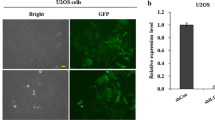Abstract
The overexpression of the type 1 insulin-like growth factor receptor (IGF-1R) has been reported to be associated with malignant transformation, tumor development and chemo- or radioresistance of tumor cells. Previously, we have reported that inhibition of IGF-1R could reverse the radioresistance of human osteosarcoma cells. However, whether inhibition of IGF-1R could enhance chemosensitivity of ostesosarcoma cells is unclear. In this study, lentivirus-mediated shRNA was employed to downregulate endogenous IGF-1R expression to study the function of IGF-1R in chemoresistance of osteosarcoma cells. Results showed that lentivirus-mediated shRNA targeting IGF-1R combined with chemotherapy (CDDP or DTX) could lead to growth suppression of osteosarcoma cells not only in vitro but also in vivo. Moreover, inhibition of IGF-1R gene combined with chemotherapy also synergistically enhanced Caspase-3-mediated apoptosis of osteosarcoma cells. The synergistical enhancement of apoptosis might be associated with downregulation of Bcl-2 and upregulation of Bax in osteosarcoma cells induced by IGF-1R inhibition. Therefore, the overexpression of IGF-1R gene might play important roles in chemoresistance of osteosarcoma cells, and lentivirus-mediated RNAi targeting IGF-1R would be an attractive anti-cancer strategy to chemosensitization of osteosarcoma cell.







Similar content being viewed by others
References
Bielack S, Carrle D, Jost L et al (2008) Osteosarcoma: ESMO clinical recommendations for diagnosis, treatment and follow-up. Ann Oncol 19:ii94–ii96
Messerschmitt PJ, Garcia RM, Abdul-Karim FW et al (2009) Osteosarcoma. J Am Acad Orthop Surg 17:515–527
Adams TE, Epa VC, Garrett TP et al (2000) Structure and function of the type 1 insulin-like growth factor receptor. Cell Mol Life Sci 57:1050–1093
Werner H, Bruchim I (2009) The insulin-like growth factor-I receptor as an oncogene. Arch Physiol Biochem 115:58–71
Rikhof B, de Jong S, Suurmeijer AJ et al (2009) The insulin-like growth factor system and sarcomas. J Pathol 217:469–482
Wang YH, Wang ZX, Qiu Y et al (2009) Lentivirus-mediated RNAi knockdown of insulin-like growth factor-1 receptor inhibits growth, reduces invasion, and enhances radiosensitivity in human osteosarcoma cells. Mol Cell Biochem 327:257–266
Chou AJ, Gorlick R (2006) Chemotherapy resistance in osteosarcoma: current challenges and future directions. Expert Rev Anticancer Ther 6:1075–1085
Huang C, Li M, Chen C et al (2008) Small interfering RNA therapy in cancer: mechanism, potential targets, and clinical applications. Expert Opin Ther Targets 12:637–645
Shinohara ET, Maity A (2009) Increasing sensitivity to radiotherapy and chemotherapy by using novel biological agents that alter the tumor microenvironment. Curr Mol Med 9:1034–1045
Godsland IF (2009) Insulin resistance and hyperinsulinaemia in the development and progression of cancer. Clin Sci (Lond) 118:315–332
Grothey A, Voigt W, Schöber C et al (1999) The role of insulin-like growth factor I and its receptor in cell growth, transformation, apoptosis, and chemoresistance in solid tumors. J Cancer Res Clin Oncol 125:166–173
Yu D, Shibuya H, Miura M (2003) Roles of the insulin-like growth factor I receptor C-terminus in cellular radioresistance. Biochem Biophys Res Commun 311:174–178
Bohula EA, Playford MP, Macaulay VM (2003) Targeting the type 1 insulin-like growth factor receptor as anti-cancer treatment. Anticancer Drugs 14:669–682
White PJ, Fogarty RD, Werther GA et al (2000) Antisense inhibition of IGF receptor expression in HaCaT keratinocytes: a model for antisense strategies in keratinocytes. Antisense Nucleic Acid Drug Dev 10:195–203
Kolb EA, Gorlick R (2009) Development of IGF-IR inhibitors in pediatric sarcomas. Curr Oncol Rep 11:307–313
Yeh J, Litz J, Hauck P, Ludwig DL et al (2008) Selective inhibition of SCLC growth by the A12 anti-IGF-1R monoclonal antibody correlates with inhibition of Akt. Lung Cancer 60:166–174
Scotlandi K, Avnet S, Benini S et al (2002) Expression of an IGF-I receptor dominant negative mutant induces apoptosis, inhibits tumorigenesis and enhances chemosensitivity in Ewing’s sarcoma cells. Int J Cancer 101:11–16
Dallas NA, Xia L, Fan F et al (2009) Chemoresistant colorectal cancer cells, the cancer stem cell phenotype, and increased sensitivity to insulin-like growth factor-I receptor inhibition. Cancer Res 69:1951–1957
Dong A, Kong M, Ma Z et al (2008) Knockdown of insulin-like growth factor 1 receptor enhances chemosensitivity to cisplatin in human lung adenocarcinoma A549 cells. Acta Biochim Biophys Sin (Shanghai) 40:497–504
Lee YJ, Imsumran A, Park MY et al (2007) Adenovirus expressing shRNA to IGF-1R enhances the chemosensitivity of lung cancer cell lines by blocking IGF-1 pathway. Lung Cancer 55:279–286
Karagiannis TC, El-Osta A (2004) siRNAs: mechanism of RNA interference, in vivo and potential clinical applications. Cancer Biol Ther 3:1069–1074
Sinn PL, Arias AC, Brogden KA et al (2008) Lentivirus vector can be readministered to nasal epithelia without blocking immune responses. J Virol 82:10684–10692
Acknowledgment
We are very grateful for the sincere help and technical support by department of biochemistry in Nanjing Medicine University.
Author information
Authors and Affiliations
Corresponding author
Rights and permissions
About this article
Cite this article
Wang, YH., Xiong, J., Wang, SF. et al. Lentivirus-mediated shRNA targeting insulin-like growth factor-1 receptor (IGF-1R) enhances chemosensitivity of osteosarcoma cells in vitro and in vivo. Mol Cell Biochem 341, 225–233 (2010). https://doi.org/10.1007/s11010-010-0453-2
Received:
Accepted:
Published:
Issue Date:
DOI: https://doi.org/10.1007/s11010-010-0453-2




